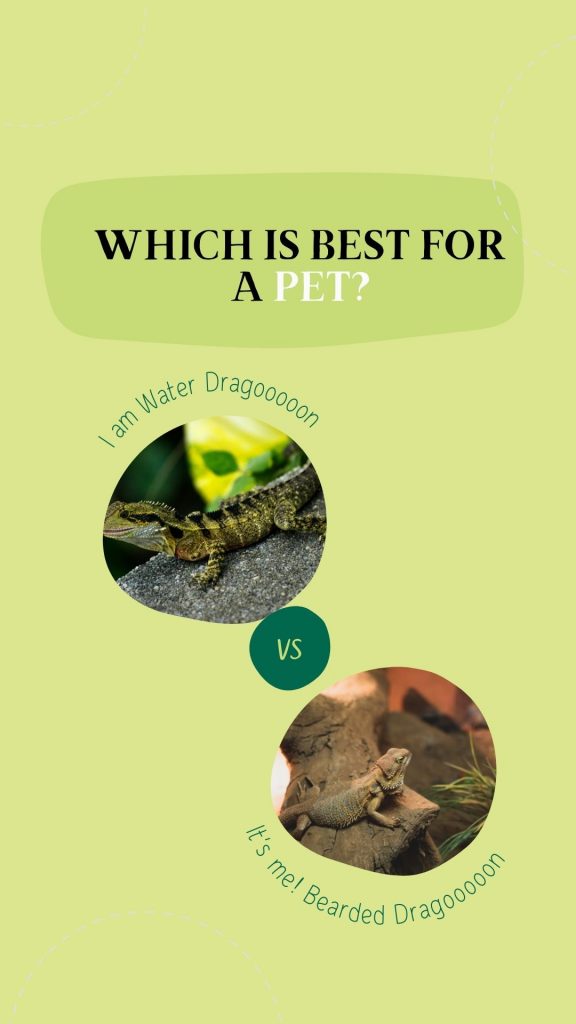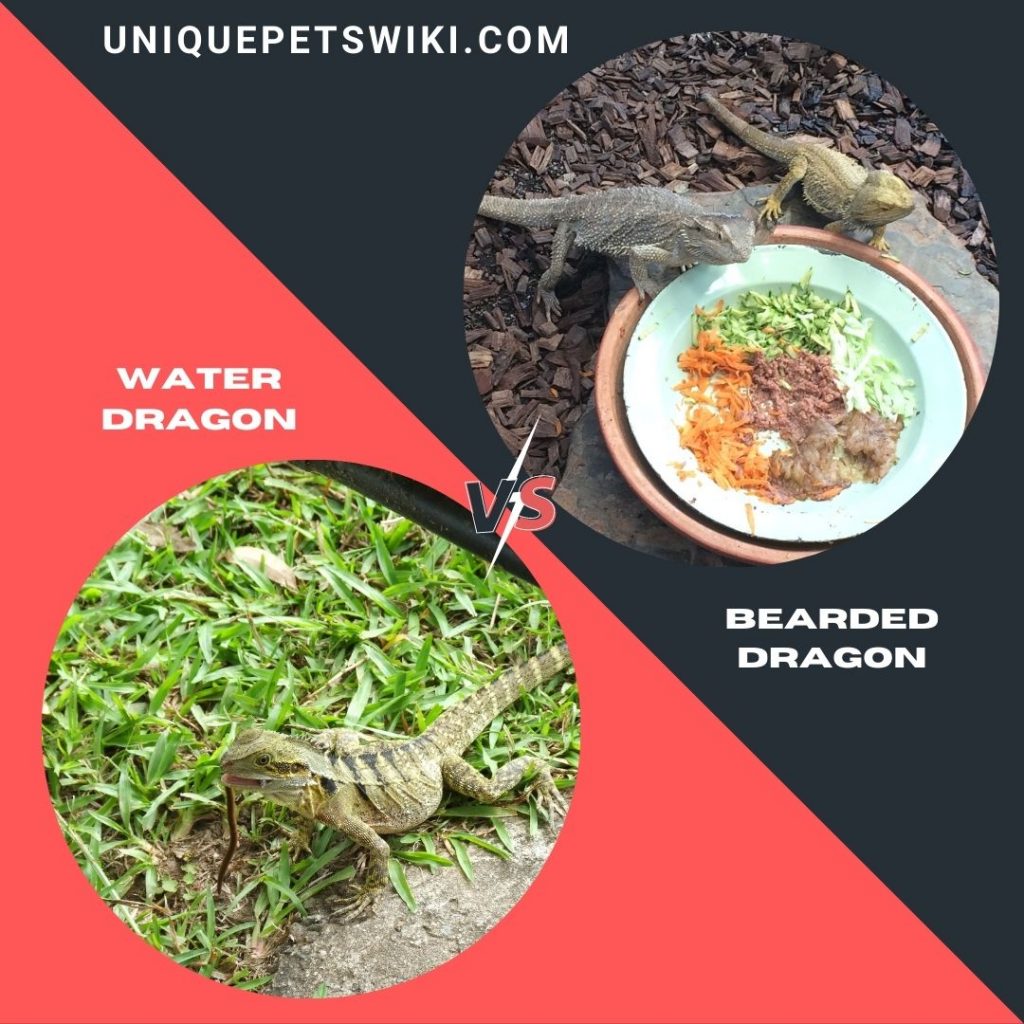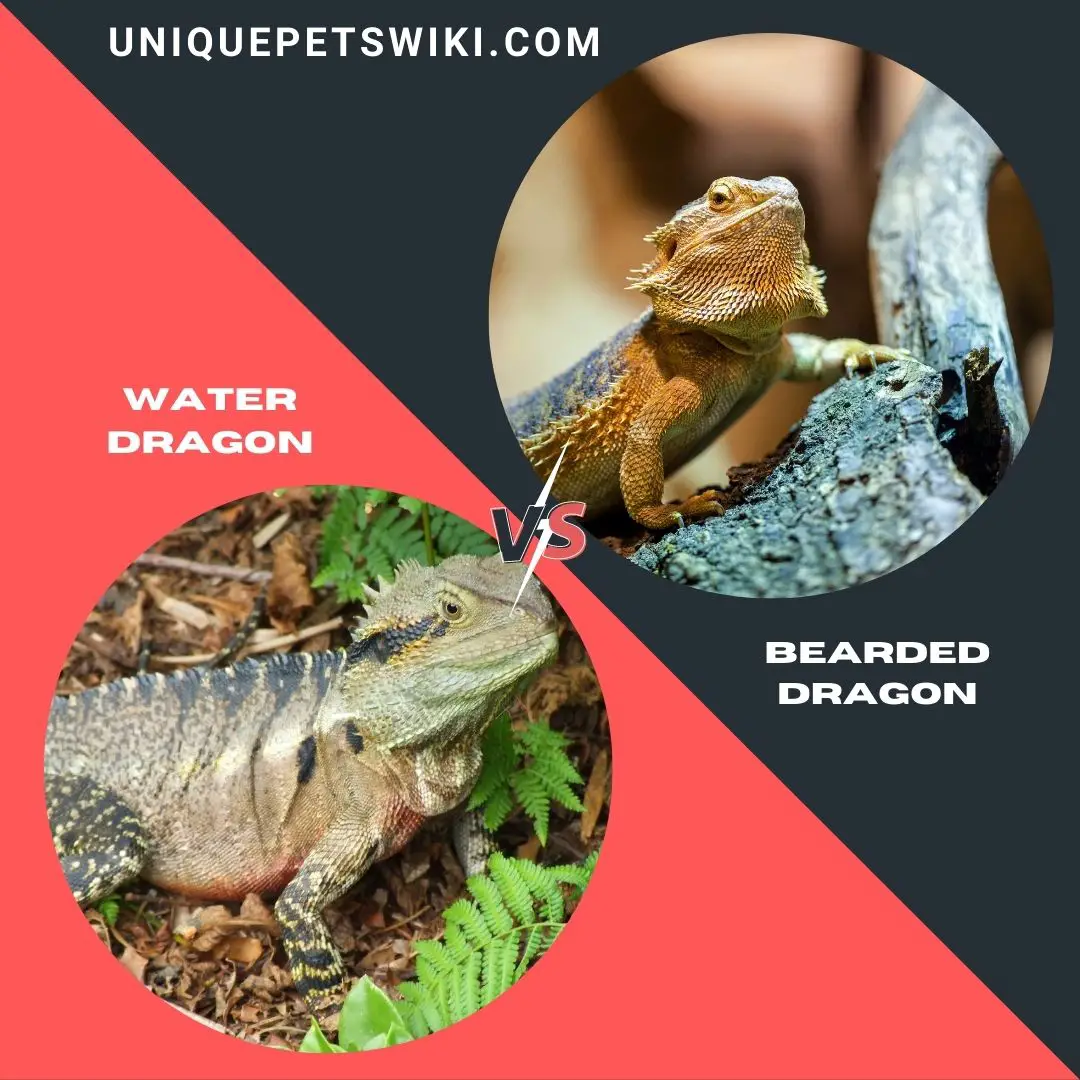“Water Dragon Vs Bearded Dragon!” which will you go for as pets? Let’s help you make the choice.
Water dragons and bearded dragons are pre-eminent lizards in the dragon family to win a man’s attention. They both make wonderful and interesting pets to have around.
One of my readers needed help with which pet to choose between, a water dragon and a bearded dragon. Lizards are my things from a long time ago, and I was glad to help him.
I couldn’t stop thinking about someone outside there who is passionate about owning a lizard but doesn’t know which one. Someone who is not sure whether to keep a water dragon or bearded dragon.
If you’re that person, then this is where to get all you need to know about these dragon pets. Keep reading for more!
Contents
Water Dragon Vs Bearded Dragon: Full comparison
Although water dragons and bearded dragons are from dragon families, their attention as pets is quite different. Before owning any animal companion, you need to know about them to help you keep a happy and healthy pet.
The same requirement is crucial when planning to own a water dragon or bearded dragon. Gather the facts about them as pets as much as you can.
Consider the diet, habitat, lifespan, personality, size, handling level, cost, etc., to know which one you can handle. It will be a very good start for you! Nothing is as interesting as having a pet you can get along well with.
Below is a full comparison of water dragons and bearded dragons that will help you decide which one will be a fantastic pet for you. Do not hesitate to note them down for easy reference.

Physical Description about Species
Water dragons have fantastic looks; their striking colors and accommodative size attract many people. They are large green dragons with long tails.
The male water dragons are more appealing; they have longer spikes and sometimes manifest a yellowish or pink coloration on the throat. Some males show beautiful coloration on their sides.

Bearded dragons‘ color is highly variable; they exist in different morphs that come with different colorations. Their color ranges from orange, grey, yellow, etc. Males and females from each morph share similar colors.
Both lizards are good-looking, and their coloration doesn’t disappoint. Therefore, which one to choose depends on your color preference.

Size, Weight, and Lifespan
Water dragons are large, with males growing up to 90-100 cm and females 60-76 cm long. Bearded dragons will grow anywhere from 43-61 cm, but larger species like German giant beardie grows to approximately 51-60 cm long.
Water dragons are quite large and require a large cage compared to the beardies that are medium-sized lizards.
The weight of the water dragon varies with size, which ranges between 0.5-1.0 kg. Mature beardies weigh anywhere from 300-510g, except the Germain giants that go even up to 1kg.
Moreover, the lifespan of both species is different. Water dragons have an average lifespan of 10-15 years but can live even for 20 years under utmost care. Bearded dragons live anywhere from 7-12 years and can reach 15 years under excellent care.
Water dragons are large, heavy, and live longest, and are desirable for people yearning to live with their pet for as long as possible. Note that for both lizards to live long requires good husbandry and care.
Habitat
Water dragon vs. bearded dragon habitat needs are quite different. The former typically dwell around permanent, standing water, e.g., swamps, riverbanks, and swamps.
These lizards are incredible climbers and enjoy a good time climbing from branches to branches. Water dragons stick to warm and humid environments.
Conversely, the beardies thrive well in warm and arid areas, including savannas, subtropical woodlands, desserts, and scrubland.
In captivity, a water dragon’s tank must have two areas; the aquatic and terrestrial. They love soaking and swimming and also hide from threats in water. Bearded dragons are purely terrestrial but require an occasional bathing.
Active Level
Water dragons are pretty active and energetic. They rarely get bored in the enclosure and are busy digging, swimming, running, and jumping across branches during the day. However, they get lazy at some points and bask under the heat source.
Similarly, the beardies are also diurnal lizards and can be both active and inactive during the day. These lizards spend their active time digging, climbing on branches, and wandering around the tank
They also spend a couple of hours basking with little or no activity at this point. Both water dragons and bearded dragons are very energetic and active during the day and sleep at night.
Personality And Handling Level
Water dragons are a bit shy and unwelcoming when you are new to them. However, when tamed from an early age, they are accustomed to staying around a person and becoming very friendly and docile. They appreciate handling.
Bearded dragons are good friends to their owners. They are friendly, docile, love being petted, and you can tame them pretty well. The beardies are more tolerant when handling and appreciate it more than water dragons.
They associate well with their owners and enjoy playing together. Both species are friendly, calm, interactive, and do not bite the owners. The major difference is that bearded dragons are easily tamed, unlike water dragons.
Defense Mechanism
If water dragons perceive threats, they dive into the water to hide and stay underwater for about 90 minutes. They also drop tails if scared or when you exert too much pressure on it.
These lizards use their long it as their defensive weapon to whip predators. Bearded dragons also have their unique way of defending themselves from predators.
When startled, the beardies open their mouth and puff up the beard that suddenly inflates and turns jet black.
This sight alone is enough to frighten and send off a predator. Bearded dragons are also famous for blending their color with the environment so that predators don’t spot them.
Both species have different tactics that they use as a defensive mechanism. They can also jump down from a person’s hands when feeling scared. The beardies don’t drop their tail, but sometimes they can break due to accidents.
Diet
Water dragons require a well-balanced diet consisting of a large portion of live food, e.g., mealworms, crickets, very small rodents, locusts, etc., and about 10-15% veggies and fruits. Some lizards might refuse to eat fruits and veggies.
Young bearded dragons eat more liver feeders and only about 25% veggies and fruits. However, the adult beardies diet primarily consists of 75% veggies and a small part of live feeders.
Both the water dragon and bearded dragon are omnivores. However, water dragons mainly eat live bugs, and while the beardies demand a lot of plant edibles as they age.

Breeding
The mating season for water dragons is in the spring and typically lasts for 2-3 months. The males attract females by expressing a couple of behaviors such as head bobbing, hand waving, throat puffing, and push-ups.
Females are ready for breeding at two years and usually lay 1-2 clutches yearly, and each clutch has around 8-12 eggs. These female dragons lay and bury their eggs in the substrates.
Bearded dragons begin to breed at 1-2 years, and their mating season is in the summer. A female can lay 2-5 clutches per year, each clutch recording 20-40 eggs. They also bury their eggs after laying.
Typically, a male dragon approaches and circles a female on estrus, which responds by bobbing her head up and down and waving her arm in a circular motion.
Bearded dragons lay a lot of eggs compared to water dragons. In addition, both species can lay eggs without mating, but they are infertile.
Required Take Care
One way to keep your pet happy is by providing ideal and comfortable housing. The exotic pets, including water dragons and bearded dragons, are looking for a similar home to the wild.
It’s, therefore, necessary to simulate conditions in their natural habitat when setting up their home in captivity. Know the correct humidity, heating, lighting, and tank size.
Enclosure Size
With water dragons being approximately a foot larger than the beardies, they need a bigger tank.
An adult water dragon thrives well in a minimum of a 60-gallon wooden vivarium, and the majority of them fit perfectly in a 75-gallon tank. Bearded dragon requires a minimum of 40-gallon vivarium but are more comfortable in a 55-gallon tank.
Both water dragons and bearded dragons can live in a wooden or plastic vivarium but with different sizes. A water dragon’s tank requires a large bowl of water to fulfill its need for an aquatic source.
Lighting, Heating, and Humidity Requirements
Lighting, humidity, and heating are primary components in the enclosure of water dragons and bearded dragons.
A water dragon’s enclosure requires a humid area; humidity in the tank should remain consistently high, remaining between 70-80%. Provision of a pan of water and frequent misting of both the dragon and enclosure is necessary.
Water dragons also need high temperatures; daytime tank temperature is 85℉ for around 10-12 hours, and night-time temps should be 75℉. They require 10-12 hours of 6-10% UVB lighting.
However, the beardies’ temperature requirements are extreme. Daytime temperatures should be between 75-85℉, and a basking spot of 90-100℉. At night, maintain the temp at around 70-75℉.
A 10-14% UVB lighting will do good with these lizards. Likewise, bearded dragons require humidity levels of around 35-40%.
Cleaning
It’s important to clean a water dragon’s enclosure regularly. Often, these dragons tend to poop in the water; thus, you need to change their water daily. Remove uneaten food from the tank every day.
Also, you will need to change the substrate weekly and clean the entire tank monthly with soap and hot water. Replace the entire substrate after cleaning.
Bearded dragons can poop on water and at different places in the tank. Spot and remove the poop, and change the water day-to-day.
Also, clean the bowls and put in fresh water daily. Remove food remaining after feeding, and then provide clean drinking water every day.
Both lizards need to stay in a clean place, eat clean food, and drink fresh water. The tanks need to be cleaned frequently and disinfected. Pooping in water reduces the awful smell of poop in the enclosure.
Suitability: Best for Whom?
Water dragons require a large enclosure for accommodation, and humidity should be maintained at high levels, making it somehow demanding and expensive.
These dragons prefer eating feeder bugs to vegetables, and this increases their budget for food. Conversely, adult bearded dragons have a better taste for vegetables than live feeders. Their enclosure is a bit smaller and doesn’t require too much humidity.
Water dragons are expensive to care for because of their complex needs, making them a perfect fit for experienced owners. Bearded dragons are the best choice for beginners.
Costs
The initial cost of a water dragon is about $40-$80, and this depends on the origin of the lizard, whether captive-bred or was obtained from the wild.
For the whole budget, including the lizard, food, tank, and all tank requirement, it will cost you approximately $1000-$2000
Bearded dragons are reasonable to keep. Buying a beardie from a breeder and pet shop with a good reputation will cost you from $60-$100. The range accounts for the different morphs of the beardies.
On the whole, the initial price of beardies, all the essentials needed in the tank, food, and tank will cost anywhere from $500-$1500. Note that some morphs are inexpensive and others costly.
Ability to Keep in Groups
Water dragons are social and can share a tank with their counterparts. One male can live peacefully well with a few females but never house two males together. Females can also fight with each other, but they become friends with time.
Bearded dragons love it most living solo. Keeping two or more beardies in a single enclosure encourages fighting, and the lizards might hurt each other.
Two-few water dragons can live together but require a much bigger tank. Bearded dragons need to live on their own.
Can You Keep Water Dragon and Bearded Dragon Together?
While you might be tempted to house a water dragon and bearded dragon under one roof, there’s nothing as risky as mixing different species. You can find one of the lizards or both seriously injured.
A water dragon enclosure is so humid that bearded dragons cannot survive in it. Also, water dragons will be challenged living in a beardie tank because the humidity is too low for them.
The husbandry needs of these two lizards vary considerably and therefore cannot live together in one tank.
Wrapping Up
Now I have no reason to stop you from settling for a water dragon or bearded dragon since you know each species’ essentials, level of care, and attributes.
The comparison of these two dragons was mainly to help you understand their differences and similarities as pets and assist you in choosing the lizard that you can handle and manage.
Both water and bearded dragons have unique reasons that make them preferred pets. They are friendly, calm, beautiful, and tameable.
We all have different preferences, and there’s a way we want our pets to look or behave. So, before you buy a pet, first make a list of the things you expect from your pet. It will help you get what you need.
